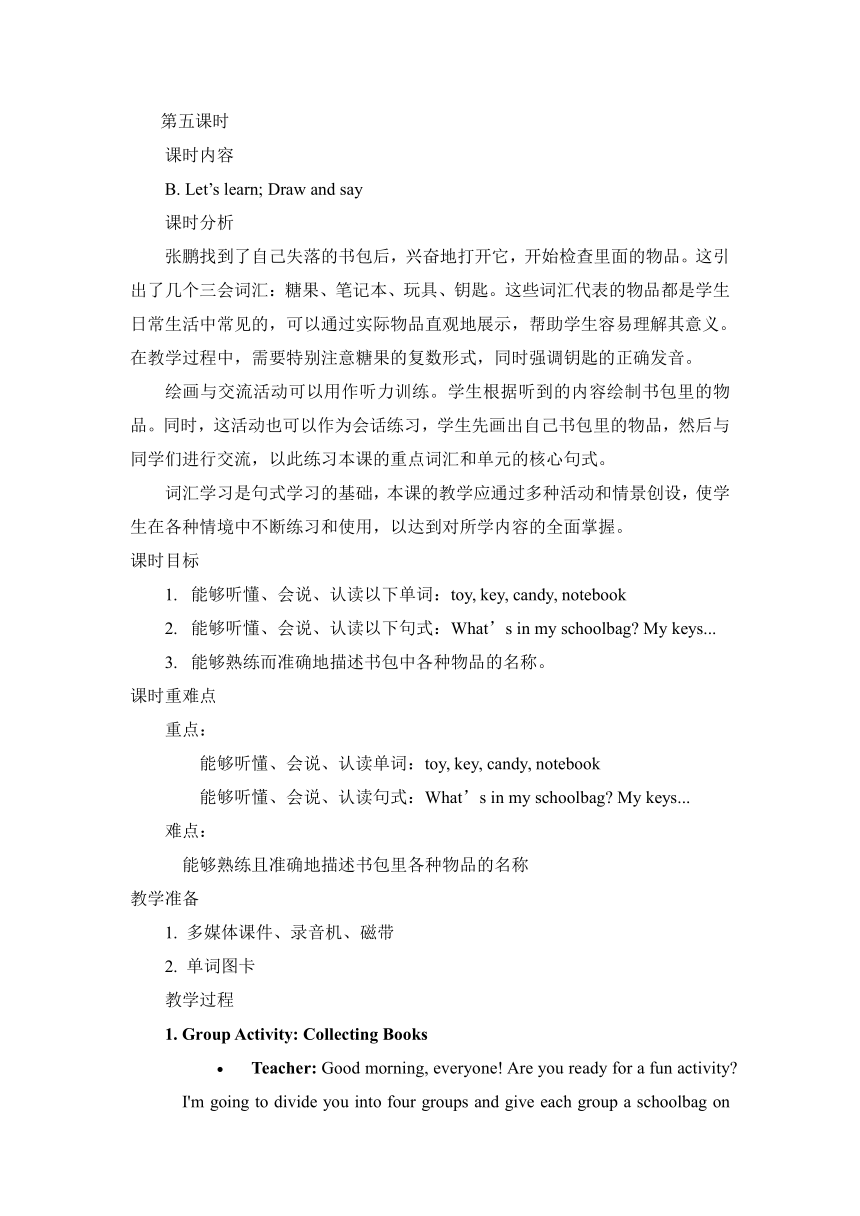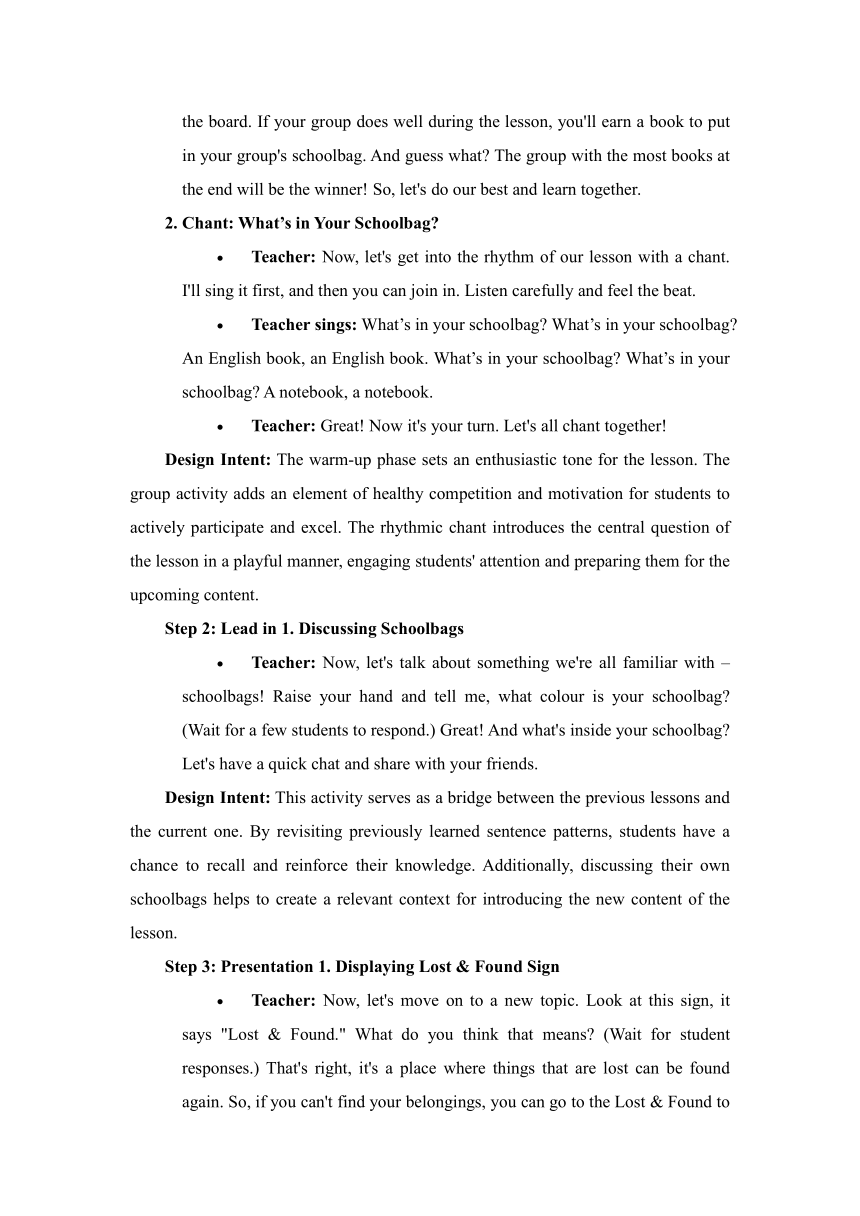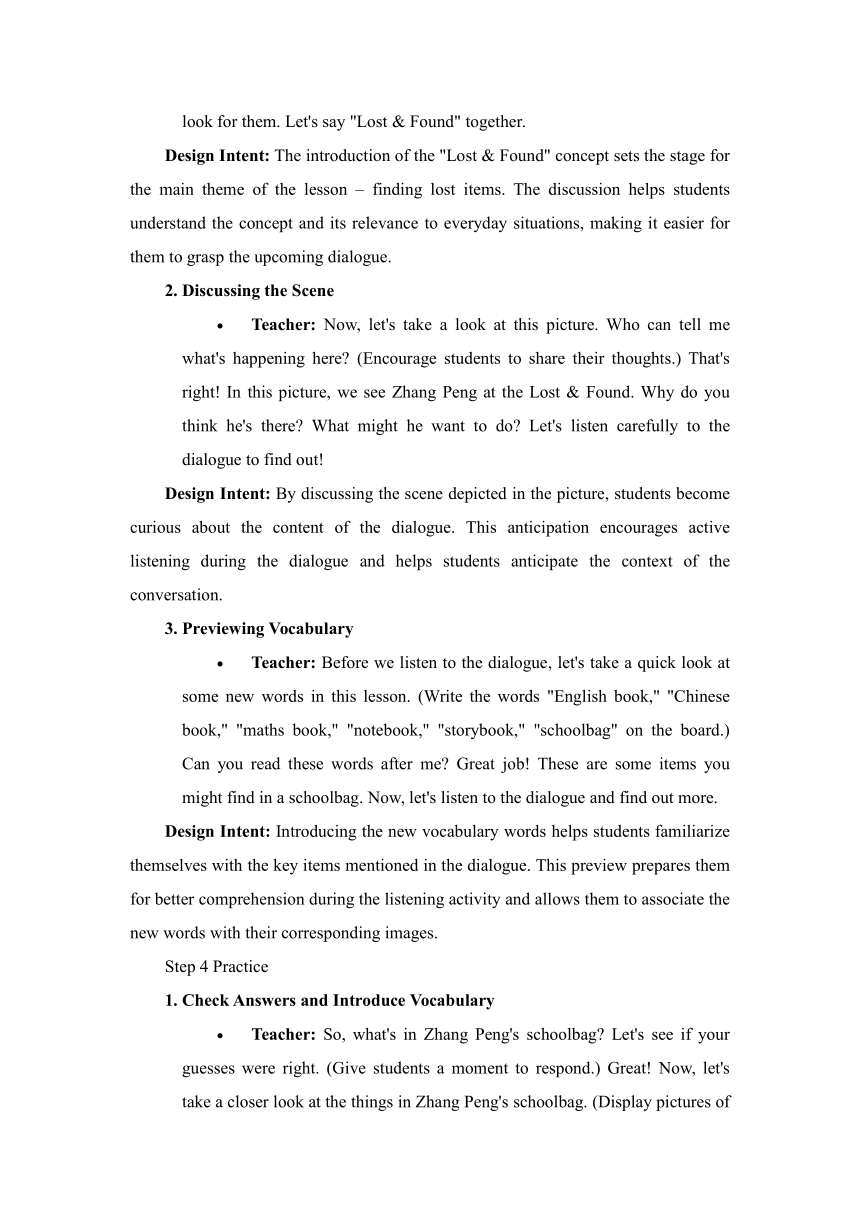Unit2 My schoolbag Part B Let’s learn 教案
文档属性
| 名称 | Unit2 My schoolbag Part B Let’s learn 教案 |  | |
| 格式 | docx | ||
| 文件大小 | 205.2KB | ||
| 资源类型 | 教案 | ||
| 版本资源 | 人教版(PEP) | ||
| 科目 | 英语 | ||
| 更新时间 | 2023-08-24 10:20:11 | ||
图片预览



文档简介
第五课时
课时内容
B. Let’s learn; Draw and say
课时分析
张鹏找到了自己失落的书包后,兴奋地打开它,开始检查里面的物品。这引出了几个三会词汇:糖果、笔记本、玩具、钥匙。这些词汇代表的物品都是学生日常生活中常见的,可以通过实际物品直观地展示,帮助学生容易理解其意义。在教学过程中,需要特别注意糖果的复数形式,同时强调钥匙的正确发音。
绘画与交流活动可以用作听力训练。学生根据听到的内容绘制书包里的物品。同时,这活动也可以作为会话练习,学生先画出自己书包里的物品,然后与同学们进行交流,以此练习本课的重点词汇和单元的核心句式。
词汇学习是句式学习的基础,本课的教学应通过多种活动和情景创设,使学生在各种情境中不断练习和使用,以达到对所学内容的全面掌握。
课时目标
能够听懂、会说、认读以下单词:toy, key, candy, notebook
能够听懂、会说、认读以下句式:What’s in my schoolbag My keys...
能够熟练而准确地描述书包中各种物品的名称。
课时重难点
重点:
能够听懂、会说、认读单词:toy, key, candy, notebook
能够听懂、会说、认读句式:What’s in my schoolbag My keys...
难点:
能够熟练且准确地描述书包里各种物品的名称
教学准备
1. 多媒体课件、录音机、磁带
2. 单词图卡
教学过程
1. Group Activity: Collecting Books
Teacher: Good morning, everyone! Are you ready for a fun activity I'm going to divide you into four groups and give each group a schoolbag on the board. If your group does well during the lesson, you'll earn a book to put in your group's schoolbag. And guess what The group with the most books at the end will be the winner! So, let's do our best and learn together.
2. Chant: What’s in Your Schoolbag
Teacher: Now, let's get into the rhythm of our lesson with a chant. I'll sing it first, and then you can join in. Listen carefully and feel the beat.
Teacher sings: What’s in your schoolbag What’s in your schoolbag An English book, an English book. What’s in your schoolbag What’s in your schoolbag A notebook, a notebook.
Teacher: Great! Now it's your turn. Let's all chant together!
Design Intent: The warm-up phase sets an enthusiastic tone for the lesson. The group activity adds an element of healthy competition and motivation for students to actively participate and excel. The rhythmic chant introduces the central question of the lesson in a playful manner, engaging students' attention and preparing them for the upcoming content.
Step 2: Lead in 1. Discussing Schoolbags
Teacher: Now, let's talk about something we're all familiar with – schoolbags! Raise your hand and tell me, what colour is your schoolbag (Wait for a few students to respond.) Great! And what's inside your schoolbag Let's have a quick chat and share with your friends.
Design Intent: This activity serves as a bridge between the previous lessons and the current one. By revisiting previously learned sentence patterns, students have a chance to recall and reinforce their knowledge. Additionally, discussing their own schoolbags helps to create a relevant context for introducing the new content of the lesson.
Step 3: Presentation 1. Displaying Lost & Found Sign
Teacher: Now, let's move on to a new topic. Look at this sign, it says "Lost & Found." What do you think that means (Wait for student responses.) That's right, it's a place where things that are lost can be found again. So, if you can't find your belongings, you can go to the Lost & Found to look for them. Let's say "Lost & Found" together.
Design Intent: The introduction of the "Lost & Found" concept sets the stage for the main theme of the lesson – finding lost items. The discussion helps students understand the concept and its relevance to everyday situations, making it easier for them to grasp the upcoming dialogue.
2. Discussing the Scene
Teacher: Now, let's take a look at this picture. Who can tell me what's happening here (Encourage students to share their thoughts.) That's right! In this picture, we see Zhang Peng at the Lost & Found. Why do you think he's there What might he want to do Let's listen carefully to the dialogue to find out!
Design Intent: By discussing the scene depicted in the picture, students become curious about the content of the dialogue. This anticipation encourages active listening during the dialogue and helps students anticipate the context of the conversation.
3. Previewing Vocabulary
Teacher: Before we listen to the dialogue, let's take a quick look at some new words in this lesson. (Write the words "English book," "Chinese book," "maths book," "notebook," "storybook," "schoolbag" on the board.) Can you read these words after me Great job! These are some items you might find in a schoolbag. Now, let's listen to the dialogue and find out more.
Design Intent: Introducing the new vocabulary words helps students familiarize themselves with the key items mentioned in the dialogue. This preview prepares them for better comprehension during the listening activity and allows them to associate the new words with their corresponding images.
Step 4 Practice
1. Check Answers and Introduce Vocabulary
Teacher: So, what's in Zhang Peng's schoolbag Let's see if your guesses were right. (Give students a moment to respond.) Great! Now, let's take a closer look at the things in Zhang Peng's schoolbag. (Display pictures of the items: key, candy, toys, notebook.) Can you say these words after me Key, candy, toys, notebook. Excellent! Let's read them together one by one. (Guide students in proper pronunciation.) Now, let's talk about each item. Do you like candies How about toys
Design Intent: This activity serves to confirm the students' predictions about the contents of Zhang Peng's schoolbag and introduces the new vocabulary words associated with each item. It's done in an interactive way, engaging students in conversations about the items while repeating and familiarizing themselves with the new words.
2. Choral Reading and Individual Practice
Teacher: Now, let's read the dialogue together. Listen carefully to the tape and read along. (Play the recording.) Excellent job! Now, I want each of you to read the dialogue on your own. Show me how well you can do it!
Design Intent: This activity combines choral reading with individual practice. The choral reading ensures that students follow the correct rhythm and intonation, while individual practice allows them to build confidence in reading the dialogue independently.
3. Role Play and Act Out
Teacher: Alright, it's time for some fun! Let's work in pairs and act out the dialogue. Decide who will be Zhang Peng and who will be the other person. Use your creativity to make it lively and exciting. Then, I'll choose a few pairs to show their fantastic performances to the class.
Design Intent: Role-playing allows students to actively engage with the dialogue and apply the vocabulary in a context. Encouraging creativity and participation adds an element of fun to the learning process and enables students to practice the dialogue naturally.
4. Vocabulary Review and Spelling
Teacher: Now, let's review the vocabulary we learned today. (Point to each item.) What's this (Students respond.) That's right, it's a key. How about this one (Continue with the other items.) Now, let's spell these words. I'll say the word, and you spell it after me. Key. (Students spell.) Candy. (Students spell.) Toys. (Students spell.) Notebook. (Students spell.)
Design Intent: This segment reinforces the new vocabulary words through recall and spelling practice. By actively participating in spelling, students become more familiar with the word forms and the pronunciation of each letter in the words.
5. Fun Review Game: "What's in the Bag "
Teacher: Are you ready for a game It's called "What's in the Bag " I'll describe something, and you have to guess what it is. If you think you know, raise your hand and tell me! (Describe items using the new vocabulary words, e.g., "It's small and made of metal. You use it to open doors.") Raise your hand if you know! Alright, let's see... (Continue describing and inviting students to guess.)
Design Intent: The review game adds an interactive and engaging element to the lesson, allowing students to apply their newly acquired vocabulary in a creative way. The game also encourages active participation and critical thinking as students listen to the descriptions and make guesses based on their understanding of the words.
These interactive and varied activities engage students in different ways, ensuring a well-rounded and engaging learning experience while helping them consolidate their understanding of the lesson's content.
Step 5 Summary
统计小组书包里物品的数量,评选最优小组。
Teacher:What’s in your schoolbag How many Which group is the best Congratulations.
设计意图:小组评价应有始有终。在课程结束,总结各小组的表现,给出最终评价,以奖励表现优异的同学,激励表现稍显不够积极的同学。
板书设计
Unit Two My schoolbag
B. Let’s learn
key notebook candy toy
What’s in your schoolbag
My keys ...
课时内容
B. Let’s learn; Draw and say
课时分析
张鹏找到了自己失落的书包后,兴奋地打开它,开始检查里面的物品。这引出了几个三会词汇:糖果、笔记本、玩具、钥匙。这些词汇代表的物品都是学生日常生活中常见的,可以通过实际物品直观地展示,帮助学生容易理解其意义。在教学过程中,需要特别注意糖果的复数形式,同时强调钥匙的正确发音。
绘画与交流活动可以用作听力训练。学生根据听到的内容绘制书包里的物品。同时,这活动也可以作为会话练习,学生先画出自己书包里的物品,然后与同学们进行交流,以此练习本课的重点词汇和单元的核心句式。
词汇学习是句式学习的基础,本课的教学应通过多种活动和情景创设,使学生在各种情境中不断练习和使用,以达到对所学内容的全面掌握。
课时目标
能够听懂、会说、认读以下单词:toy, key, candy, notebook
能够听懂、会说、认读以下句式:What’s in my schoolbag My keys...
能够熟练而准确地描述书包中各种物品的名称。
课时重难点
重点:
能够听懂、会说、认读单词:toy, key, candy, notebook
能够听懂、会说、认读句式:What’s in my schoolbag My keys...
难点:
能够熟练且准确地描述书包里各种物品的名称
教学准备
1. 多媒体课件、录音机、磁带
2. 单词图卡
教学过程
1. Group Activity: Collecting Books
Teacher: Good morning, everyone! Are you ready for a fun activity I'm going to divide you into four groups and give each group a schoolbag on the board. If your group does well during the lesson, you'll earn a book to put in your group's schoolbag. And guess what The group with the most books at the end will be the winner! So, let's do our best and learn together.
2. Chant: What’s in Your Schoolbag
Teacher: Now, let's get into the rhythm of our lesson with a chant. I'll sing it first, and then you can join in. Listen carefully and feel the beat.
Teacher sings: What’s in your schoolbag What’s in your schoolbag An English book, an English book. What’s in your schoolbag What’s in your schoolbag A notebook, a notebook.
Teacher: Great! Now it's your turn. Let's all chant together!
Design Intent: The warm-up phase sets an enthusiastic tone for the lesson. The group activity adds an element of healthy competition and motivation for students to actively participate and excel. The rhythmic chant introduces the central question of the lesson in a playful manner, engaging students' attention and preparing them for the upcoming content.
Step 2: Lead in 1. Discussing Schoolbags
Teacher: Now, let's talk about something we're all familiar with – schoolbags! Raise your hand and tell me, what colour is your schoolbag (Wait for a few students to respond.) Great! And what's inside your schoolbag Let's have a quick chat and share with your friends.
Design Intent: This activity serves as a bridge between the previous lessons and the current one. By revisiting previously learned sentence patterns, students have a chance to recall and reinforce their knowledge. Additionally, discussing their own schoolbags helps to create a relevant context for introducing the new content of the lesson.
Step 3: Presentation 1. Displaying Lost & Found Sign
Teacher: Now, let's move on to a new topic. Look at this sign, it says "Lost & Found." What do you think that means (Wait for student responses.) That's right, it's a place where things that are lost can be found again. So, if you can't find your belongings, you can go to the Lost & Found to look for them. Let's say "Lost & Found" together.
Design Intent: The introduction of the "Lost & Found" concept sets the stage for the main theme of the lesson – finding lost items. The discussion helps students understand the concept and its relevance to everyday situations, making it easier for them to grasp the upcoming dialogue.
2. Discussing the Scene
Teacher: Now, let's take a look at this picture. Who can tell me what's happening here (Encourage students to share their thoughts.) That's right! In this picture, we see Zhang Peng at the Lost & Found. Why do you think he's there What might he want to do Let's listen carefully to the dialogue to find out!
Design Intent: By discussing the scene depicted in the picture, students become curious about the content of the dialogue. This anticipation encourages active listening during the dialogue and helps students anticipate the context of the conversation.
3. Previewing Vocabulary
Teacher: Before we listen to the dialogue, let's take a quick look at some new words in this lesson. (Write the words "English book," "Chinese book," "maths book," "notebook," "storybook," "schoolbag" on the board.) Can you read these words after me Great job! These are some items you might find in a schoolbag. Now, let's listen to the dialogue and find out more.
Design Intent: Introducing the new vocabulary words helps students familiarize themselves with the key items mentioned in the dialogue. This preview prepares them for better comprehension during the listening activity and allows them to associate the new words with their corresponding images.
Step 4 Practice
1. Check Answers and Introduce Vocabulary
Teacher: So, what's in Zhang Peng's schoolbag Let's see if your guesses were right. (Give students a moment to respond.) Great! Now, let's take a closer look at the things in Zhang Peng's schoolbag. (Display pictures of the items: key, candy, toys, notebook.) Can you say these words after me Key, candy, toys, notebook. Excellent! Let's read them together one by one. (Guide students in proper pronunciation.) Now, let's talk about each item. Do you like candies How about toys
Design Intent: This activity serves to confirm the students' predictions about the contents of Zhang Peng's schoolbag and introduces the new vocabulary words associated with each item. It's done in an interactive way, engaging students in conversations about the items while repeating and familiarizing themselves with the new words.
2. Choral Reading and Individual Practice
Teacher: Now, let's read the dialogue together. Listen carefully to the tape and read along. (Play the recording.) Excellent job! Now, I want each of you to read the dialogue on your own. Show me how well you can do it!
Design Intent: This activity combines choral reading with individual practice. The choral reading ensures that students follow the correct rhythm and intonation, while individual practice allows them to build confidence in reading the dialogue independently.
3. Role Play and Act Out
Teacher: Alright, it's time for some fun! Let's work in pairs and act out the dialogue. Decide who will be Zhang Peng and who will be the other person. Use your creativity to make it lively and exciting. Then, I'll choose a few pairs to show their fantastic performances to the class.
Design Intent: Role-playing allows students to actively engage with the dialogue and apply the vocabulary in a context. Encouraging creativity and participation adds an element of fun to the learning process and enables students to practice the dialogue naturally.
4. Vocabulary Review and Spelling
Teacher: Now, let's review the vocabulary we learned today. (Point to each item.) What's this (Students respond.) That's right, it's a key. How about this one (Continue with the other items.) Now, let's spell these words. I'll say the word, and you spell it after me. Key. (Students spell.) Candy. (Students spell.) Toys. (Students spell.) Notebook. (Students spell.)
Design Intent: This segment reinforces the new vocabulary words through recall and spelling practice. By actively participating in spelling, students become more familiar with the word forms and the pronunciation of each letter in the words.
5. Fun Review Game: "What's in the Bag "
Teacher: Are you ready for a game It's called "What's in the Bag " I'll describe something, and you have to guess what it is. If you think you know, raise your hand and tell me! (Describe items using the new vocabulary words, e.g., "It's small and made of metal. You use it to open doors.") Raise your hand if you know! Alright, let's see... (Continue describing and inviting students to guess.)
Design Intent: The review game adds an interactive and engaging element to the lesson, allowing students to apply their newly acquired vocabulary in a creative way. The game also encourages active participation and critical thinking as students listen to the descriptions and make guesses based on their understanding of the words.
These interactive and varied activities engage students in different ways, ensuring a well-rounded and engaging learning experience while helping them consolidate their understanding of the lesson's content.
Step 5 Summary
统计小组书包里物品的数量,评选最优小组。
Teacher:What’s in your schoolbag How many Which group is the best Congratulations.
设计意图:小组评价应有始有终。在课程结束,总结各小组的表现,给出最终评价,以奖励表现优异的同学,激励表现稍显不够积极的同学。
板书设计
Unit Two My schoolbag
B. Let’s learn
key notebook candy toy
What’s in your schoolbag
My keys ...
